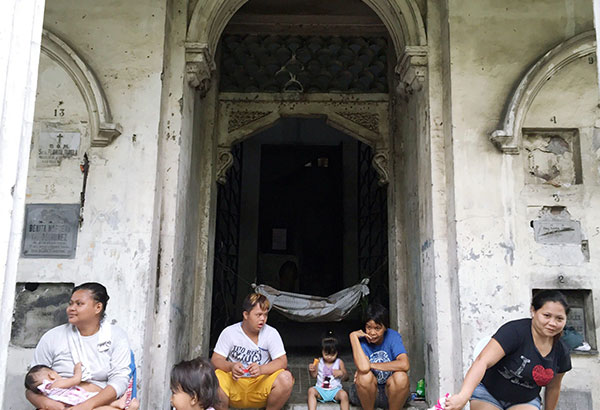Living with the dead: Tomb is home to caretakers

Photo shows the dwelling of Nati Cuaresma Lim’s family inside the La Loma Catholic Cemetery. Marc Jason Cayabyab
MANILA, Philippines — For 25 years, Nati Cuaresma Lim has been living with her family of graveyard caretakers at the La Loma Catholic Cemetery in Caloocan City, looking after a century-old mausoleum.
A makeshift hammock lulls Nati’s grandchild to sleep, hanging below the arched entrance where “Mausoleo di Sto. Enterro” or Mausoleum of the Holy Interment is carved on graying stone.
Surrounding Nati’s home are several lapida (tombstones), years of grime covering the dates of death, some going back to the 1920s. Behind the mausoleum is a decaying altar of the Blessed Virgin.
Nati’s daughter Joanna has brought her three children, who run about, not minding the dead all around them. Her daughter Lenlen came with her partner Daisy and the latter’s daughter Dainty. The brother of her husband also brought his sons.
Inside, the family’s laundry hang on a clothesline, while Joanna’s unfinished high school certificate was neatly tucked before a lapida. A tarpaulin bearing the face of Nati’s husband Alfredo is tied at the foot of the stairs going up to the mausoleum’s terrace.
There, skeletons are scattered and tucked inside one room, beside the room where Nati has spread out her carton bed.
Since Japanese occupation
Nati, 49, told The STAR that according to her late husband Alfredo Lim Jr. (no relation to the former Manila mayor), his parents and grandparents took on the task of taking care of the mausoleum since the Japanese occupation.
If her story is to be believed, her husband’s ancestors inherited the task from the Japanese, who overtook this historic cemetery during the war.
“We have been cleaning the dead since we were young until I had grandchildren,” Nati said as she cradled her granddaughter.
Sleeping in the mausoleum, Nati claimed to have seen restless spirits of those who have died almost a century ago, from a Spanish friar with chains on his feet to Japanese soldiers talking to each other in the dark.
Nati said an underground tunnel connected the mausoleum to a nearby funerary chapel called “Lumang Simbahan.” Her husband’s father used to caution them against going inside the tunnels for fear of bombs.
Her daughters Lenlen and Joanna help her take care of the graves they call their “alaga.” Some families pay them a few hundred pesos to take care of the tombs of their loved ones.
‘Happy kind of sad’
Frenaldo Lim, 55, Nati’s brother-in-law, said the Lim family has been living in the mausoleum since the 1970s, but they were forced to move out in the 2000s to the informal communities nearby after the management prohibited families from living among the tombs.
“We prefer living here though,” Frenaldo said. “It’s a happy kind of sad. It’s lively here if it’s Undas, but after that, it’s quiet here again.”
He earns at most P10,000 from October to November cleaning and painting the tombs for P300 to P500 each.
“Be afraid of the living, not the dead,” Frenaldo said when asked why they like living with the dead.
Birthday with the departed
Nati’s daughter Joanna, 23, said she remembered celebrating her seventh birthday inside the mausoleum, with balloons were tied on the pillars to give a festive air. Five years later, she would encounter the ghost of a nun.
“When I was 12 years old, I was taking a bath at the back when I saw the ghost of a nun holding a child. I was so scared I ran inside with soap in my ears,” Joanna recounted.
She said taking care of this mausoleum has been passed on through generations by their great-grandparents. She has continued the trade of cleaning graveyards as a lucrative livelihood, especially during Undas.
“They don’t have wealth to bestow upon us. This is already the treasure that we will inherit,” Joanna said.
“People say the cemetery is only for the dead, but they don’t know there also lives the living,” she added. “We prefer to live here because it’s quiet. When you wake up, you won’t think of electricity costs and the rent.”
Her sister Lenlen smiled at the thought that they are a family of graveyard caretakers.
“This is our tradition that we have since made a living of,” Lenlen, 27, said.
Strengthening family bonds
Sen. Grace Poe yesterday said Filipinos’ traditional observance of All Saints’ Day and All Souls’ Day is an opportunity to strengthen the bonds of families.
“Remembering our departed loved ones during All Saints’ Day and All Souls’ Day is a long-standing tradition of the Filipino family,” Poe said in a statement.
“May this year’s observance serve as a fitting occasion to strengthen and affirm our family ties,” she said. – With Paolo Romero
- Latest
- Trending




























